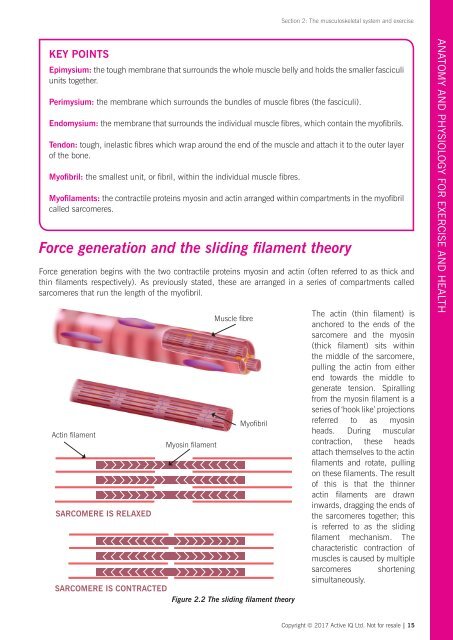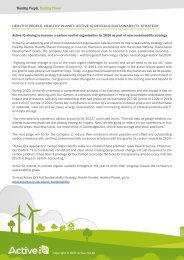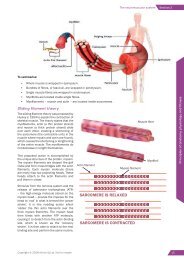Create successful ePaper yourself
Turn your PDF publications into a flip-book with our unique Google optimized e-Paper software.
Section 2: The musculoskeletal system and exercise<br />
KEY POINTS<br />
Epimysium: the tough membrane that surrounds the whole muscle belly and holds the smaller fasciculi<br />
units together.<br />
Perimysium: the membrane which surrounds the bundles of muscle fibres (the fasciculi).<br />
Endomysium: the membrane that surrounds the <strong>in</strong>dividual muscle fibres, which conta<strong>in</strong> the myofibrils.<br />
Tendon: tough, <strong>in</strong>elastic fibres which wrap around the end of the muscle and attach it to the outer layer<br />
of the bone.<br />
Myofibril: the smallest unit, or fibril, with<strong>in</strong> the <strong>in</strong>dividual muscle fibres.<br />
Myofilaments: the contractile prote<strong>in</strong>s myos<strong>in</strong> and act<strong>in</strong> arranged with<strong>in</strong> compartments <strong>in</strong> the myofibril<br />
called sarcomeres.<br />
Force generation and the slid<strong>in</strong>g filament theory<br />
Force generation beg<strong>in</strong>s with the two contractile prote<strong>in</strong>s myos<strong>in</strong> and act<strong>in</strong> (often referred to as thick and<br />
th<strong>in</strong> filaments respectively). As previously stated, these are arranged <strong>in</strong> a series of compartments called<br />
sarcomeres that run the length of the myofibril.<br />
Act<strong>in</strong> filament<br />
SARCOMERE IS RELAXED<br />
SARCOMERE IS CONTRACTED<br />
Myos<strong>in</strong> filament<br />
Muscle fibre<br />
Myofibril<br />
Figure 2.2 The slid<strong>in</strong>g filament theory<br />
The act<strong>in</strong> (th<strong>in</strong> filament) is<br />
anchored to the ends of the<br />
sarcomere and the myos<strong>in</strong><br />
(thick filament) sits with<strong>in</strong><br />
the middle of the sarcomere,<br />
pull<strong>in</strong>g the act<strong>in</strong> from either<br />
end towards the middle to<br />
generate tension. Spirall<strong>in</strong>g<br />
from the myos<strong>in</strong> filament is a<br />
series of ‘hook like’ projections<br />
referred to as myos<strong>in</strong><br />
heads. Dur<strong>in</strong>g muscular<br />
contraction, these heads<br />
attach themselves to the act<strong>in</strong><br />
filaments and rotate, pull<strong>in</strong>g<br />
on these filaments. The result<br />
of this is that the th<strong>in</strong>ner<br />
act<strong>in</strong> filaments are drawn<br />
<strong>in</strong>wards, dragg<strong>in</strong>g the ends of<br />
the sarcomeres together; this<br />
is referred to as the slid<strong>in</strong>g<br />
filament mechanism. The<br />
characteristic contraction of<br />
muscles is caused by multiple<br />
sarcomeres shorten<strong>in</strong>g<br />
simultaneously.<br />
Anatomy and physiology for exercise and health<br />
Copyright © 2017 <strong>Active</strong> <strong>IQ</strong> Ltd. Not for resale | 15

















